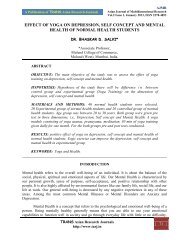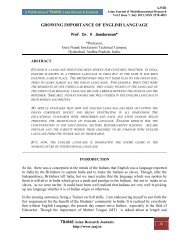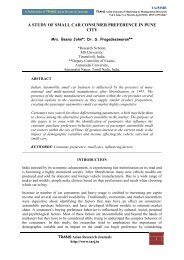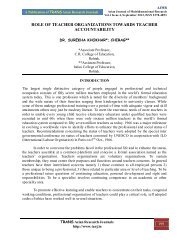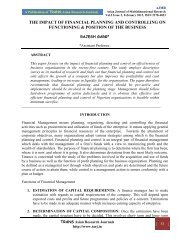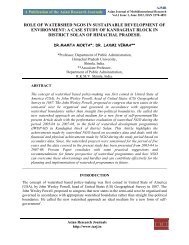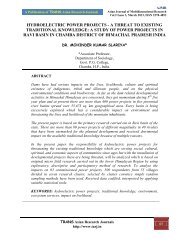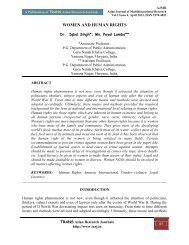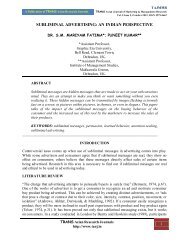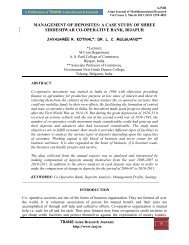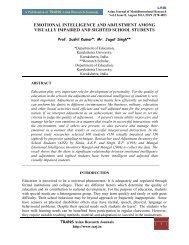4.3, Dr. Saravanan, T.pdf - tarj.in
4.3, Dr. Saravanan, T.pdf - tarj.in
4.3, Dr. Saravanan, T.pdf - tarj.in
Create successful ePaper yourself
Turn your PDF publications into a flip-book with our unique Google optimized e-Paper software.
A Publication of TRANS Asian Research Journals<br />
AJMR<br />
Asian Journal of Multidimensional Research<br />
Vol.2 Issue 4, April 2013, ISSN 2278-4853<br />
A DIALOGUE ON LIS RESEARCH ISSUES BETWEEN<br />
PROF. SRIMURUGAN.A AND SARAVANAN.T: A SIMULATION<br />
ABSTRACT<br />
<strong>Dr</strong>. <strong>Saravanan</strong>.T*<br />
*Assistant Professor,<br />
Department of Library & Information Science,<br />
Annamalai University,<br />
Tamilnadu, India.<br />
In any discipl<strong>in</strong>e research plays a vital role as it acts as the backbone for the<br />
decision makers, who are <strong>in</strong> the need of certa<strong>in</strong> solutions for their problems. The LIS<br />
discipl<strong>in</strong>e researchers are able to conduct the research <strong>in</strong> multiple dimensions as<br />
they have more scope to carry out the research <strong>in</strong> different tracks rather than other<br />
discipl<strong>in</strong>es. Some of the consequences that are related to the research have been<br />
presented here <strong>in</strong> a dialogue manner as happened between <strong>Saravanan</strong>, T and Prof.<br />
Srimurugan, A, who was the Head & Librarian, Department of Library &<br />
Information Science, Madurai Kamaraj University, Tamilnadu. This paper<br />
encompasses a few research aspects related to objectives, hypotheses, statistical<br />
methods, packages, theoretical design, EDA etc.<br />
KEYWORDS: Social Science; LIS; Research; statistics; experimental designs.<br />
______________________________________________________________________________<br />
INTRODUCTION<br />
Awareness on any issues, which are related to the research are compulsory one for the LIS<br />
researchers, so as they can conduct a good research <strong>in</strong> the right track. Information explosion<br />
greatly helps the LIS researchers to conduct the research <strong>in</strong> various aspects with advanced IT<br />
tools offered by the modern digital era. The skills that are required for the modern LIS<br />
professionals to conduct the research have been briefly discussed here. The issues that are related<br />
with the quality of the research are given towards a dialogue format <strong>in</strong> order to enable the readers<br />
for better capture. Author of this paper has raised some of the research questions and they were<br />
clarified by his teacher Professor Emeritus Srimurugan, A the former Head & Librarian,<br />
Department of Library & Information Science, Madurai Kamaraj University, Tamilnadu. The<br />
conversation between them gives some valuable tips for the LIS or any researchers, who are keen<br />
to conduct the successful research with the required quality.<br />
<strong>Saravanan</strong>, T: Good morn<strong>in</strong>g Teacher. It’s my pleasure to meet you aga<strong>in</strong>.<br />
Prof. Srimurugan, A: Good morn<strong>in</strong>g <strong>Saravanan</strong>! Nice to see you. Are you f<strong>in</strong>e? How are your<br />
academic activities mov<strong>in</strong>g?<br />
TRANS Asian Research Journals<br />
http://www.<strong>tarj</strong>.<strong>in</strong><br />
25
A Publication of TRANS Asian Research Journals<br />
AJMR<br />
Asian Journal of Multidimensional Research<br />
Vol.2 Issue 4, April 2013, ISSN 2278-4853<br />
<strong>Saravanan</strong>, T: Teacher! I am f<strong>in</strong>e and hope that you are well. The activities are on their tracks.<br />
Prof. Srimurugan, A: Good. Let me know the purpose of your visit.<br />
<strong>Saravanan</strong>, T: Sure sir. I have some questions related to the social sciences research. Could you<br />
please clear up them?<br />
Prof. Srimurugan, A: Def<strong>in</strong>itely. Move ahead.<br />
<strong>Saravanan</strong>, T: Teacher! Can researches be conducted without clearly identify<strong>in</strong>g the Objectives?<br />
Prof. Srimurugan, A: No. The objectives of any research must be clear and should not be vague,<br />
as they help the researchers to formulate a good structure by which the further designs would be<br />
possible. Structure your objectives carefully before start the research.<br />
<strong>Saravanan</strong>, T: Teacher, <strong>in</strong> many researches, I have observed that the researchers were applied the<br />
simple percentages only for the study. Is it accepted?<br />
Prof. Srimurugan, A: Better you may recall the statement of W.G.Miller (2011) . “There is not<br />
much po<strong>in</strong>t <strong>in</strong> simply report<strong>in</strong>g a frequency or percentage if there is no <strong>in</strong>dication of whether or<br />
not the observed value(s) are greater than one would expect due to random sampl<strong>in</strong>g variability.<br />
The statistical test should be applied to determ<strong>in</strong>e whether percentages are greater than those<br />
expected by chance.”<br />
<strong>Saravanan</strong>, T: Teacher, Is it possible to conduct the research without formulat<strong>in</strong>g the hypotheses?<br />
Prof. Srimurugan, A: Hypotheses are must to test the validity of researchers’ assumption. We<br />
gather sample data and determ<strong>in</strong>e the difference between the hypothesized value and the actual<br />
value of the sample mean, and judge whether the difference is significant. The smaller the<br />
difference, the greater the likelihood that our hypothesized value for mean is correct. However,<br />
recall the statement of Richard I Lev<strong>in</strong> and David S Rub<strong>in</strong> ( 2009) - - “In hypothesis test<strong>in</strong>g as <strong>in</strong><br />
most significant real-life decisions, clear-cut solutions are the exceptions, not the rule. The<br />
bottom l<strong>in</strong>e <strong>in</strong> hypothesis test<strong>in</strong>g is when we ask ourselves (and then decide) whether a<br />
population like we th<strong>in</strong>k this one is would be likely to produce a sample like the one we are<br />
look<strong>in</strong>g at.”<br />
Further W.G.Miller (2011) also has <strong>in</strong>sisted that the editors of the journals would not accept<br />
research without clear specification of hypotheses and alternative hypotheses, the sample size,<br />
the method of sampl<strong>in</strong>g, the error rates and the appropriate test of the hypotheses.<br />
<strong>Saravanan</strong>, T: Teacher, Could you please expla<strong>in</strong> the role of statistics <strong>in</strong> the research?<br />
Prof. Srimurugan, A: Don’t forget that the statistical methods always help us to make <strong>in</strong>ferences<br />
about the population towards the observed sample. Further the status of the hypotheses whether<br />
accepted or rejected could be identified when we apply<strong>in</strong>g the appropriate statistical methods.<br />
Hence mak<strong>in</strong>g conclusions without adequate statistical tools would not give a right output.<br />
TRANS Asian Research Journals<br />
http://www.<strong>tarj</strong>.<strong>in</strong><br />
26
A Publication of TRANS Asian Research Journals<br />
AJMR<br />
Asian Journal of Multidimensional Research<br />
Vol.2 Issue 4, April 2013, ISSN 2278-4853<br />
<strong>Saravanan</strong>, T: Teacher, How can I perform the data analysis by <strong>in</strong>corporat<strong>in</strong>g the modern<br />
technology?<br />
Prof. Srimurugan, A: Data analysis by us<strong>in</strong>g the statistical packages has proliferated <strong>in</strong> tandem<br />
with the rapid progress of computer hardware. Modern technology offers many packages to the<br />
social scientists to carry out the analysis and it enables them to accomplish their research task<br />
without much burdens.<br />
<strong>Dr</strong>. <strong>Saravanan</strong>, T: Teacher, Could you please give me the necessity of the statistical packages,<br />
which are familiar at <strong>in</strong>ternational level?<br />
Prof. Srimurugan. A: Why not? Many sophisticated packages are available <strong>in</strong> the market, which<br />
may satisfy your requirements. Remember that except a few tools majority of the packages are<br />
fee based versions. Remember that the some of the packages always require the programm<strong>in</strong>g<br />
knowledge of the researcher, who is <strong>in</strong>terested to analyze the data with the packages. Hence you<br />
are expected to have adequate programm<strong>in</strong>g skills (if the package needs) as well as strong base<br />
<strong>in</strong> the statistics part to work <strong>in</strong> any statistical packages. Keep it <strong>in</strong> your m<strong>in</strong>d that poor skills <strong>in</strong><br />
the said areas may lead you to make wrong analysis/mis<strong>in</strong>terpretation and wrong <strong>in</strong>ferences,<br />
which will spoil your entire research.<br />
<strong>Saravanan</strong>, T: Teacher, Could you please expla<strong>in</strong> the role of theory and experimental design <strong>in</strong><br />
multivariate analysis?<br />
Prof. Srimurugan, A: Dear student, just imag<strong>in</strong>e the task, which is before you that may help to<br />
solve a jigsaw puzzle. Please recall the Lipseys’ (1990) statement -- “Theory orientation may have<br />
its greatest advantage <strong>in</strong> the doma<strong>in</strong> of practical research design. The puzzle helps to match the<br />
pictures and suggests what are the additional we required to complete it. Like that theory offers<br />
a fundamental base <strong>in</strong> formulat<strong>in</strong>g any research design, analysis, <strong>in</strong>terpretation, etc. The social<br />
scientists must structure a well def<strong>in</strong>ed theory to carry out the research <strong>in</strong> right track.<br />
<strong>Saravanan</strong>, T: Teacher, What are the possibilities do the social scientists have to analyze the<br />
multivariate data?<br />
Prof. Srimurugan, A: Dear student, I suggest you to go through the statement of Cattel (1998a) and<br />
Nunnally (1991) -- “Researchers can concurrently exam<strong>in</strong>e common and specific variance<br />
components of large, multiple variable data sets, which better affords the opportunity to model<br />
complex causality, measurement error, and the effects of mediat<strong>in</strong>g variables.” The<br />
hierarchically nested variance components allow the researcher to better exam<strong>in</strong>e correlated and<br />
uncorrelated multilevel data ( 1992) .<br />
<strong>Saravanan</strong>, T: Teacher, What do you mean by the level of measurements?<br />
Prof. Srimurugan. A: The quality of rat<strong>in</strong>g may be a critical one to the success of any research.<br />
The characteristics of the object must be evaluated by us<strong>in</strong>g the rat<strong>in</strong>g scales. The object which<br />
you want to rate may be a person or th<strong>in</strong>g or a process etc. The levels are usually measured as<br />
nom<strong>in</strong>al, ord<strong>in</strong>al and scale.<br />
TRANS Asian Research Journals<br />
http://www.<strong>tarj</strong>.<strong>in</strong><br />
27
A Publication of TRANS Asian Research Journals<br />
AJMR<br />
Asian Journal of Multidimensional Research<br />
Vol.2 Issue 4, April 2013, ISSN 2278-4853<br />
<strong>Saravanan</strong>, T: Teacher, What are the procedures I have to consider while analyz<strong>in</strong>g the data?<br />
Prof. Srimurugan, A: Dear student, you must approach the data with flexibility and exercise your<br />
own judgment rather than follow the mathematically prescribed rules 6 . Data analysis should<br />
advance two primary scientific goals; identify<strong>in</strong>g patterns of regularity <strong>in</strong> the social or natural<br />
world, and communicat<strong>in</strong>g about these patterns <strong>in</strong> a way that is accessible to people who are<br />
<strong>in</strong>terested. Researchers should be concerned with these goals rather than ask<strong>in</strong>g the question as<br />
what you have raised now. Every researcher is expected to analyze and <strong>in</strong>terpret the data<br />
properly.<br />
<strong>Saravanan</strong>, T: Teacher, What about the graphical displays <strong>in</strong> the research? Are they a must for<br />
the research?<br />
Prof. Srimurugan, A: Yes, the graphical items are a must as they reveal the <strong>in</strong>formation, which is<br />
difficult to observe from large data sets. Remember the statement of Tukey (1969) -- “Plot and<br />
eyes” is the most diverse channel to the human m<strong>in</strong>d. Further, Anscombe (1973) has said that how<br />
simple graphical summaries can show trends that are lost <strong>in</strong> quantitative summaries of data. It is<br />
the duty of the every researcher to identify the required graphical items for their study.<br />
<strong>Saravanan</strong>, T: Teacher, What are the factors I have to consider to determ<strong>in</strong>e the sample size<br />
when us<strong>in</strong>g MANOVA?<br />
Prof. Srimurugan, A: Dear student, you have to consider five factors (2000) while us<strong>in</strong>g<br />
MANOVA. They are; a) Type I error b) Type II error c) number of cells d) number of outcome<br />
variables 5) size of the effect of <strong>in</strong>terest.<br />
<strong>Saravanan</strong>, T: Teacher, Could you please expla<strong>in</strong> the Type I and Type II error?<br />
Prof. Srimurugan, A : Dear student, you may recall the statement of W.G. Miller (2007) --“The<br />
researcher must learn about the relationship between a dependent variables standard deviations<br />
and the errors of <strong>in</strong>ference for samples of various size. They should, of course be equally<br />
concerned about accept<strong>in</strong>g a null hypothesis when, <strong>in</strong> fact, <strong>in</strong> the population sampled they should<br />
reject the null hypothesis.<br />
<strong>Saravanan</strong>, T: Teacher, Can I adopt the time series analysis <strong>in</strong> LIS research?<br />
Prof. Srimurugan, A: Yes, a time series analysis is a set of repeated observation of a variable on<br />
some entity where the number of repetitions is relatively large. The time series data may <strong>in</strong>clude<br />
year, month, week and day. This study can be applicable <strong>in</strong> LIS research to predict the authors’<br />
collaborations, documents growth etc. Remember that the time series analysis requires large size<br />
of data.<br />
<strong>Saravanan</strong>, T: Teacher, Could you please expla<strong>in</strong> the multidimensional scal<strong>in</strong>g (MDS)?<br />
Prof. Srimurugan, A: Among the various models MDS is one of the techniques that can be<br />
adopted <strong>in</strong> LIS research to shape the research that adds more strength to ensure its quality. Recall<br />
TRANS Asian Research Journals<br />
http://www.<strong>tarj</strong>.<strong>in</strong><br />
28
A Publication of TRANS Asian Research Journals<br />
AJMR<br />
Asian Journal of Multidimensional Research<br />
Vol.2 Issue 4, April 2013, ISSN 2278-4853<br />
the statement which was given by Mark L Davison and Stephen G Sireli (2000) -- “MDS is a<br />
versatile technique for understand<strong>in</strong>g and display<strong>in</strong>g the structure of multivariate data.”<br />
<strong>Saravanan</strong>, T: Teacher, How can I handle the problems concern<strong>in</strong>g with miss<strong>in</strong>g data?<br />
Prof. Srimurugan, A: Dear student, while process<strong>in</strong>g the data the miss<strong>in</strong>g data should get more<br />
attention from the researcher. Take care to identify the data which is miss<strong>in</strong>g <strong>in</strong> your analysis<br />
otherwise that will affect the estimation and <strong>in</strong>ferential process adversely. It must be a primary<br />
concern of your research to exam<strong>in</strong>e the miss<strong>in</strong>g data that enables you to select the required<br />
action.<br />
<strong>Saravanan</strong>, T: Teacher, Do the available packages provide the facilities to handle the miss<strong>in</strong>g<br />
data problem?<br />
Prof. Srimurugan, A: Yes, the standard packages are all conta<strong>in</strong><strong>in</strong>g the provision to solve the<br />
problems, which are related with the miss<strong>in</strong>g data. However the count of numeric digits which<br />
have been used <strong>in</strong> the design<strong>in</strong>g section to identify the miss<strong>in</strong>g data may differ from package to<br />
package as they have its own pre def<strong>in</strong>ed formats.<br />
<strong>Saravanan</strong>, T: Teacher, Could you please expla<strong>in</strong> the role of ethics <strong>in</strong> Research?<br />
Prof. Srimurugan, A: Dear Student, you should know that ethics always helps to regulate our<br />
professional behaviors. Here, I would like to recall the words of Robert, M. Davison (2005) --“The<br />
authors should have an ethical obligation to ensure that they do make a significant <strong>in</strong>tellectual<br />
contribution to any jo<strong>in</strong>t publication. Each one must be able to defend his/her actions <strong>in</strong> any<br />
situation by means of ethical pr<strong>in</strong>ciples and reason<strong>in</strong>g.” He has discussed about the ethical issues<br />
under various head<strong>in</strong>gs of which the research and publication play an important role.<br />
<strong>Saravanan</strong>, T: Teacher, What are the suggestions you would like to give for the welfare of LIS<br />
researchers?<br />
Prof. Srimurugan, A: The researchers, who are <strong>in</strong> the LIS sector must realize their role as well as<br />
the importance of the research so as they can come forward to sharpen the research with the new<br />
ideas and <strong>in</strong>novative concepts. They must update their skills <strong>in</strong> various levels to compete with<br />
the researchers of other discipl<strong>in</strong>es. Many sophisticated statistical methods are available here to<br />
strengthen the research and they must be utilized properly by the researcher. The LIS researcher<br />
should adopt the different k<strong>in</strong>ds of statistical methods so as they can avoid the repeated analysis<br />
procedures. Develop<strong>in</strong>g our skills <strong>in</strong> the research as well as <strong>in</strong> statistical packages are also<br />
essential th<strong>in</strong>gs <strong>in</strong> LIS discipl<strong>in</strong>e. LIS professionals should not always depend on the statistical<br />
experts to process the research. They must stand by their own legs. Modern LIS professionals are<br />
expected to possess adequate capacity not only <strong>in</strong> the <strong>in</strong>formation organization sector but <strong>in</strong> the<br />
track of research also. You should not forget that the research is the first and foremost tool <strong>in</strong> any<br />
decision mak<strong>in</strong>g process.<br />
Dear student, I hope that you have captured enough details.<br />
TRANS Asian Research Journals<br />
http://www.<strong>tarj</strong>.<strong>in</strong><br />
29
A Publication of TRANS Asian Research Journals<br />
AJMR<br />
Asian Journal of Multidimensional Research<br />
Vol.2 Issue 4, April 2013, ISSN 2278-4853<br />
<strong>Saravanan</strong>, T: Certa<strong>in</strong>ly Teacher! I have learnt enough from your desk to refresh my knowledge.<br />
It will help the LIS researchers also, to ensure the quality of our research <strong>in</strong> various dimensions.<br />
Let me owe my s<strong>in</strong>cere thanks for the wonderful time, I spent at your cab<strong>in</strong> for clarify<strong>in</strong>g the<br />
research related doubts.<br />
Prof. Srimurugan, A: As a teacher it’s my duty and pleasure to help the students like you. Don’t<br />
forget that the duty of the teacher is not tak<strong>in</strong>g the decisions, but make the students to take the<br />
right decisions. Here, our responsibilities are to create the Librarians, and the Teachers with the<br />
adequate skills. However, keep it <strong>in</strong> your m<strong>in</strong>d that research plays a vital role <strong>in</strong> both the fields.<br />
<strong>Saravanan</strong>, T: Thank you teacher. With your k<strong>in</strong>d permission shall I make a move now?<br />
Prof. Srimurugan, A: Sure. You are always welcome to the door steps of my cab<strong>in</strong> that will be<br />
opened anytime for you people all.<br />
Wish you all the best.<br />
CONCLUSION<br />
A research was conducted by the researchers of Melbourne Institute of Applied Economics and<br />
Social Research, University of Melbourne to rank the higher education system of various<br />
countries. Of the 50 countries, India’s higher education system has been ranked at the 48 th place.<br />
The overall score of the country is lowest because there is no one area where it has performed<br />
well (Source: IASLIC Newsletter, June 2012). It would be the responsibility of the researchers to<br />
take care of their researches <strong>in</strong> terms of quality and orig<strong>in</strong>ality. Of course, this paper is not<br />
concentrated on any advanced users, who are well <strong>in</strong> their research. It aims to explore a few<br />
basics of the research requirements for those who are <strong>in</strong> the stage of beg<strong>in</strong>n<strong>in</strong>g <strong>in</strong> their research.<br />
Because lack of skills <strong>in</strong> research always lead the researchers to commit major/m<strong>in</strong>or mistakes<br />
while fram<strong>in</strong>g objectives, hypotheses, choos<strong>in</strong>g appropriate statistical tools, and mak<strong>in</strong>g<br />
<strong>in</strong>ferences etc. Roger stern et.al (2002) stated that “It is a good idea to make some mistakes. Some<br />
users are “naturals” at mak<strong>in</strong>g mistakes, but, if you are not, then make some deliberate errors.” I<br />
do th<strong>in</strong>k, mistakes enable the authors to take more care so as they would not commit mistakes<br />
aga<strong>in</strong> <strong>in</strong> some other research. LIS researchers can shape their research as good with the help of<br />
available sophisticated tools. Still, I do receive various journals’ editorial boards suggestions,<br />
comments etc., for my papers. Some time the editors’/referees’ expectations were fulfilled by<br />
my reply and they did give me a slot <strong>in</strong> their publications, whereas some time they didn’t.<br />
However, other rooms may welcome us. Remember that the product, which has the value <strong>in</strong> the<br />
market, would be def<strong>in</strong>itely approached by the consumers. The important th<strong>in</strong>g is under any<br />
circumstances the research should not slip from its own track. Th<strong>in</strong>k about the new experimental<br />
designs and step forward with <strong>in</strong>novative ideas. It would be always better to stay away from the<br />
piracy. LIS researchers should not compromise <strong>in</strong> their research <strong>in</strong> order to ensure the quality of<br />
research.<br />
TRANS Asian Research Journals<br />
http://www.<strong>tarj</strong>.<strong>in</strong><br />
30
A Publication of TRANS Asian Research Journals<br />
AJMR<br />
Asian Journal of Multidimensional Research<br />
Vol.2 Issue 4, April 2013, ISSN 2278-4853<br />
REFERENCES<br />
1. Anscombe, F.J. ”Graphs <strong>in</strong> statistical analysis”, <strong>in</strong> Applied Multivariate statistics and<br />
Mathematical Model<strong>in</strong>g, ed. Howard E.A. T<strong>in</strong>sley and Steven D. Brown. (San Diego:<br />
Academic Press, 2000). Orig<strong>in</strong>ally published <strong>in</strong> The American Statistician, 27 (1973):<br />
17-21,<br />
2. Bryk, A.S.,& Raudenbush, S.W(1992). “Hierarchical l<strong>in</strong>ear models: Applications and<br />
data analysis methods” <strong>in</strong> Applied Multivariate statistics and Mathematical Model<strong>in</strong>g,<br />
ed. Howard E.A. T<strong>in</strong>sley and Steven D. Brown. (San Diego: Academic Press, 2000).<br />
Orig<strong>in</strong>ally published <strong>in</strong> (Newbury park, CA: Sage, 1992).<br />
3. Carl J Huberty and Martha, D. Petoskey.”Multivariate Analysis of Variance and<br />
Covariance” <strong>in</strong> Applied Multivariate statistics and Mathematical Model<strong>in</strong>g, ed. Howard<br />
E.A. T<strong>in</strong>sley and Steven D. Brown. (San Diego: Academic Press, 2000).<br />
4. Cattell, R.B. ”Psychological Theory and scientific method” In J. R. ed. Nesselroad &<br />
R.B. attell. Handbook of multivariate experimental psychology. (New York: Plenum<br />
Press, 1998a).<br />
5. Lipsey, M.W.”Theory as method: small theories of treatments, Research methodology:<br />
Strengthen<strong>in</strong>g casual <strong>in</strong>terpretations of non-experimental data”, <strong>in</strong> Applied Multivariate<br />
statistics and Mathematical Model<strong>in</strong>g, ed. Howard E.A. T<strong>in</strong>sley and Steven D. Brown.<br />
(San Diego: Academic Press, 2000). Orig<strong>in</strong>ally published <strong>in</strong> (Wash<strong>in</strong>gton DC: U.S.<br />
Department of Health and Human Services, 1990).<br />
6. Mark L Davison and Stephen G, Sireli.”Multidimensional Scal<strong>in</strong>g” <strong>in</strong> Applied<br />
Multivariate statistics and Mathematical Model<strong>in</strong>g, ed. Howard E.A. T<strong>in</strong>sley and Steven<br />
D. Brown. (San Diego: Academic Press, 2000).<br />
7. Nunnally, J.C. “Psychometric theory”, <strong>in</strong> Applied Multivariate statistics and<br />
Mathematical Model<strong>in</strong>g, ed. Howard E.A. T<strong>in</strong>sley and Steven D. Brown. (San Diego:<br />
Academic Press, 2000). Orig<strong>in</strong>ally published <strong>in</strong> (New York: McGraw-Hill, 1991).<br />
8. Richard I. Lev<strong>in</strong> and David S. Rub<strong>in</strong>. Statistics for Management, 7th ed. New Delhi:<br />
Prentice Hall, 2009.<br />
9. Roger Stern et al. Introduction to Instat plus. 2002. Accessed April 17, 2011,<br />
http://www.rdg.ac.uk/<br />
10. Robert,M.Davison. “Ethical Issues” <strong>in</strong> Research and Information Systems. Ed. David<br />
Avison and Jan Ppies-Heje. (Amsterdam: Elsevier, 2005)<br />
11. Tukey, J.W.”Analyz<strong>in</strong>g data: Sanctification or detective work?”, <strong>in</strong> Applied Multivariate<br />
statistics and Mathematical Model<strong>in</strong>g, ed. Howard E.A. T<strong>in</strong>sley and Steven D. Brown.<br />
(San Diego: Academic Press, 2000). Orig<strong>in</strong>ally published <strong>in</strong> American Psychologist.<br />
(1969)<br />
TRANS Asian Research Journals<br />
http://www.<strong>tarj</strong>.<strong>in</strong><br />
31
A Publication of TRANS Asian Research Journals<br />
AJMR<br />
Asian Journal of Multidimensional Research<br />
Vol.2 Issue 4, April 2013, ISSN 2278-4853<br />
12. W. G. Miller. “Simulations.” Openstat Reference manual, 2007.<br />
13. W. G. Miller, e-mail message to author, January 01, 2011.<br />
TRANS Asian Research Journals<br />
http://www.<strong>tarj</strong>.<strong>in</strong><br />
32



